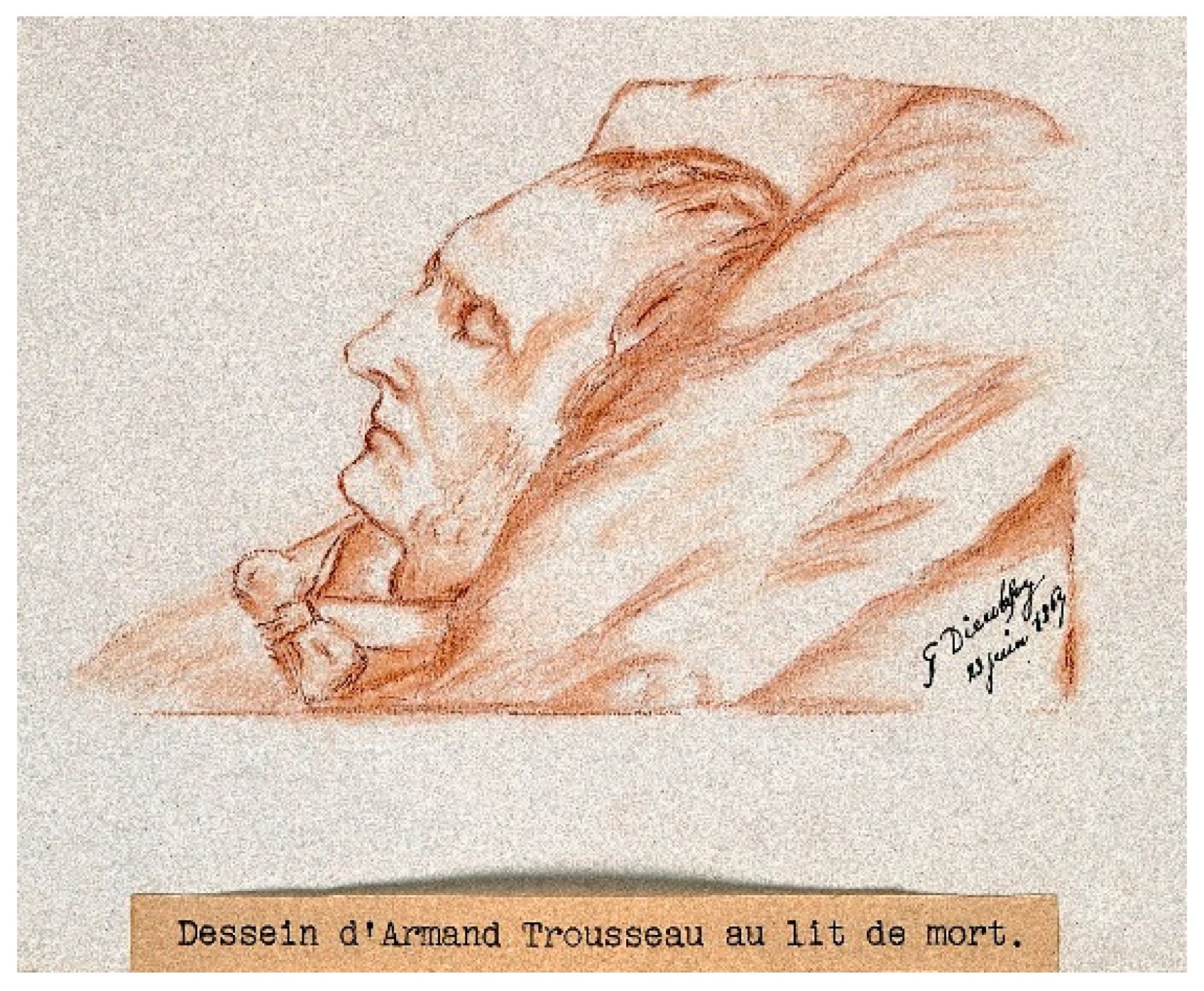The History of Armand Trousseau and Cancer-Associated Thrombosis
“Je suis perdu; une phlegmatia qui vient de se déclarer cette nuit, ne me laisse aucun doute sur nature de mon mal.”—Armand Trousseau [1]
“I am lost; a phlebitis which has declared itself this night leaves me no doubt about the nature of my illness.”
References
- Soubiran, A. Est-il roi dans quelque ile? Ou le dernier noel de trousseau. La Presse Med. 1967, 75, 2807–2810. [Google Scholar]
- Rentetzi, M. Trafficking Materials and Gendered Experimental Practices: Radium Research in Early 20th Century Vienna; Columbia University Press: New York, NY, USA; Chichester, UK, 2008. [Google Scholar]
- Roguin, A. Rene theophile hyacinthe laënnec (1781–1826): The man behind the stethoscope. Clin. Med. Res. 2006, 4, 230–235. [Google Scholar] [CrossRef] [PubMed]
- Aron, E. Le centième anniversaire de la mort de a. Trousseau. La Presse Med. 1967, 75, 1429–1430. [Google Scholar]
- Moore, M.D.; Fahey, T.J. Armand trousseau 1801–1867. In Surgical Endocrinopathies: Clinical Management and the Founding Figures, 1st ed.; Pasieka, J.L., Lee, J.A., Eds.; Springer International Publishing: Basel, Switzerland, 2015; pp. 177–179. [Google Scholar]
- Ruffner, J.A. Eponyms Dictionaries Index; Gale Research: Detroit, MI, USA, 1977. [Google Scholar]
- Trousseau, A. Phlegmatia alba dolens. In Clinique Médicale de L’hôtel-dieu de Paris, 2nd ed.; J.-B. Baillière et fils: Paris, France, 1865; Volume 3, pp. 654–712. [Google Scholar]
- Trousseau, A. Phlegmasia alba dolens. In Clinique Medicale de l’Hotel-Dieu de Paris (Lectures on Clinical Medicine at the Hotel-Dieu, Paris); Cormack, J.R., Ed.; New Sydenham Society: London, UK, 1872; Volume 5, pp. 281–332. [Google Scholar]
- Bouillaud, S.; Bouillaud, J. De l’obliteration des veines et de son influence sur la formation des hydropisies partielles: Consideration sur la hydropisies passive et general. Arch. Gen. Med. 1823, 1, 188–204. [Google Scholar]
- Rolleston, J.D. Jean baptiste bouillaud (1796–1881). A pioneer in cardiology and neurology. Proc. R. Soc. Med. 1931, 24, 1253–1262. [Google Scholar] [PubMed]
- Dieulafoy, G.; Trousseau, A. Red chalk drawing by g. Dieulafoy, 1867. Credit: Wellcome Collection. CC BY. Available online: https://wellcomecollection.org/works/z3tnagpb (accessed on 22 March 2018).
- Bizzozero, J. Ueber einen neuen formbestandtheil des blutes und dessen rolle bei der thrombose und der blutgerinnung. Archiv für Pathologische Anatomie und Physiologie und für klinische Medicin 1882, 90, 261–332. [Google Scholar] [CrossRef]
- Abdol Razak, N.B.; Jones, G.; Bhandari, M.; Berndt, M.C.; Metharom, P. Cancer-associated thrombosis: An overview of mechanisms, risk factors, and treatment. Cancers 2018, 10, 380. [Google Scholar] [CrossRef] [PubMed]
- Frere, C.; Benzidia, I.; Marjanovic, Z.; Farge, D. Recent advances in the management of cancer-associated thrombosis: New hopes but new challenges. Cancers 2019, 11, 71. [Google Scholar] [CrossRef] [PubMed]
- Scotté, F.; Leroy, P.; Chastenet, M.; Aumont, L.; Benatar, V.; Elalamy, I. Treatment and prevention of cancer-associated thrombosis in frail patients: Tailored management. Cancers 2019, 11, 48. [Google Scholar] [CrossRef] [PubMed]
- Zanetto, A.; Campello, E.; Spiezia, L.; Burra, P.; Simioni, P.; Russo, F.P. Cancer-associated thrombosis in cirrhotic patients with hepatocellular carcinoma. Cancers 2018, 10, 450. [Google Scholar] [CrossRef] [PubMed]
- Riondino, S.; Ferroni, P.; Zanzotto, F.M.; Roselli, M.; Guadagni, F. Predicting vte in cancer patients: Candidate biomarkers and risk assessment models. Cancers 2019, 11, 95. [Google Scholar] [CrossRef] [PubMed]
- Alexander, M.; Ball, D.; Solomon, B.; MacManus, M.; Manser, R.; Riedel, B.; Westerman, D.; Evans, S.M.; Wolfe, R.; Burbury, K. Dynamic thromboembolic risk modelling to target appropriate preventative strategies for patients with non-small cell lung cancer. Cancers 2019, 11, 50. [Google Scholar] [CrossRef] [PubMed]
- Al-Samkari, H.; Connors, J.M. The role of direct oral anticoagulants in treatment of cancer-associated thrombosis. Cancers 2018, 10, 271. [Google Scholar] [CrossRef] [PubMed]
- Bruno, A.; Dovizio, M.; Tacconelli, S.; Contursi, A.; Ballerini, P.; Patrignani, P. Antithrombotic agents and cancer. Cancers 2018, 10, 253. [Google Scholar] [CrossRef] [PubMed]
- Grandoni, F.; Alberio, L. Direct oral anticoagulant drugs: On the treatment of cancer-related venous thromboembolism and their potential anti-neoplastic effect. Cancers 2019, 11, 46. [Google Scholar] [CrossRef] [PubMed]
- Plantureux, L.; Mège, D.; Crescence, L.; Dignat-George, F.; Dubois, C.; Panicot-Dubois, L. Impacts of cancer on platelet production, activation and education and mechanisms of cancer-associated thrombosis. Cancers 2018, 10, 441. [Google Scholar] [CrossRef] [PubMed]
- Reddel, C.J.; Tan, C.W.; Chen, V.M. Thrombin generation and cancer: Contributors and consequences. Cancers 2019, 11, 100. [Google Scholar] [CrossRef] [PubMed]
- Wojtukiewicz, M.Z.; Hempel, D.; Sierko, E.; Tucker, S.C.; Honn, K.V. Endothelial protein c receptor (epcr), protease activated receptor-1 (par-1) and their interplay in cancer growth and metastatic dissemination. Cancers 2019, 11, 51. [Google Scholar] [CrossRef] [PubMed]
- Luu, S.; Gardiner, E.E.; Andrews, R.K. Bone marrow defects and platelet function: A focus on mds and cll. Cancers 2018, 10, 147. [Google Scholar] [CrossRef] [PubMed]

© 2019 by the authors. Licensee MDPI, Basel, Switzerland. This article is an open access article distributed under the terms and conditions of the Creative Commons Attribution (CC BY) license (http://creativecommons.org/licenses/by/4.0/).
Share and Cite
Metharom, P.; Falasca, M.; Berndt, M.C. The History of Armand Trousseau and Cancer-Associated Thrombosis. Cancers 2019, 11, 158. https://doi.org/10.3390/cancers11020158
Metharom P, Falasca M, Berndt MC. The History of Armand Trousseau and Cancer-Associated Thrombosis. Cancers. 2019; 11(2):158. https://doi.org/10.3390/cancers11020158
Chicago/Turabian StyleMetharom, Pat, Marco Falasca, and Michael C Berndt. 2019. "The History of Armand Trousseau and Cancer-Associated Thrombosis" Cancers 11, no. 2: 158. https://doi.org/10.3390/cancers11020158
APA StyleMetharom, P., Falasca, M., & Berndt, M. C. (2019). The History of Armand Trousseau and Cancer-Associated Thrombosis. Cancers, 11(2), 158. https://doi.org/10.3390/cancers11020158




